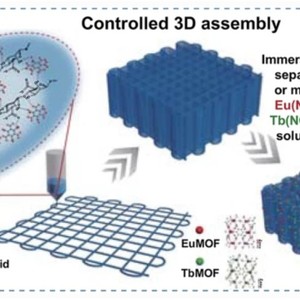Controlled Assembly of Luminescent Lanthanide-Organic Frameworks via Post-Treatment of 3D-Printed Objects
Citation
Jiahui Huang, and Peiyi Wu*. Controlled Assembly of Luminescent Lanthanide-Organic Frameworks Via Post-Treatment of 3D-Printed Objects. Nano-Micro Lett. 2021, 13, 15.
Abstract
Complex multiscale assemblies of metal–organic frameworks are essential in the construction of large-scale optical platforms but often restricted by their bulk nature and conventional techniques. The integration of nanomaterials and 3D printing technologies allows the fabrication of multiscale functional architectures. Our study reports a unique method of controlled 3D assembly purely relying on the post-printing treatment of printed constructs. By immersing a 3D-printed patterned construct consisting of organic ligand in a solution of lanthanide ions, in situ growth of lanthanide metal–organic frameworks (LnMOFs) can rapidly occur, resulting in macroscopic assemblies and tunable fluorescence properties. This phenomenon, caused by coordination and chelation of lanthanide ions, also renders a sub-millimeter resolution and high shape fidelity. As a proof of concept, a type of 3D assembled LnMOFs-based optical sensing platform has demonstrated the feasibility in response to small molecules such as acetone. It is anticipated that the facile printing and design approach developed in this work can be applied to fabricate bespoke multiscale architectures of functional materials with controlled assembly, bringing a realistic and economic prospect.


